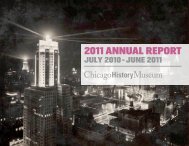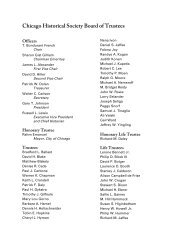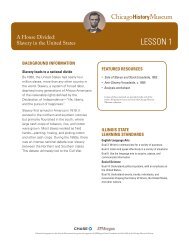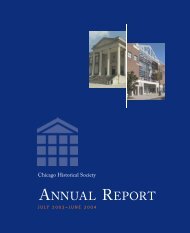Justice for the Child: The Beginning of the Juvenile Court in Chicago
Justice for the Child: The Beginning of the Juvenile Court in Chicago
Justice for the Child: The Beginning of the Juvenile Court in Chicago
Create successful ePaper yourself
Turn your PDF publications into a flip-book with our unique Google optimized e-Paper software.
<strong>Justice</strong> <strong>for</strong> <strong>the</strong> <strong>Child</strong>: <strong>The</strong> <strong>Beg<strong>in</strong>n<strong>in</strong>g</strong><br />
<strong>of</strong> <strong>the</strong> <strong>Juvenile</strong> <strong>Court</strong> <strong>in</strong> <strong>Chicago</strong><br />
DAVID S. TANENHAUS<br />
To save young boys from be<strong>in</strong>g locked<br />
up with “murderers, anarchists,<br />
and hardened crim<strong>in</strong>als,” a group<br />
<strong>of</strong> <strong>Chicago</strong> politicians, lawyers, and<br />
activists pooled <strong>the</strong>ir ef<strong>for</strong>ts to create<br />
<strong>the</strong> nation’s first juvenile court.<br />
In 1888, Lucy Flower, a transplanted Wiscons<strong>in</strong><br />
re<strong>for</strong>mer whose public service dated back to <strong>the</strong><br />
Woman’s Relief Corps <strong>of</strong> <strong>the</strong> Civil War, declared<br />
that <strong>Chicago</strong> needed a special “parental court” to<br />
hear <strong>the</strong> cases <strong>of</strong> all dependent, neglected, and del<strong>in</strong>quent<br />
children under sixteen years <strong>of</strong> age <strong>in</strong> <strong>the</strong> city. This<br />
vision earned her <strong>the</strong> appellation “mo<strong>the</strong>r <strong>of</strong> <strong>the</strong> juvenile<br />
court,” although it would take more than a decade <strong>of</strong><br />
concerted ef<strong>for</strong>t be<strong>for</strong>e this vision would become an<br />
<strong>in</strong>stitutional reality.<br />
<strong>The</strong> <strong>Chicago</strong> crusade that Flower led represented a<br />
local manifestation <strong>of</strong> <strong>the</strong> transatlantic social movement<br />
<strong>in</strong> <strong>the</strong> 1880s and 1890s to solve <strong>the</strong> problems <strong>of</strong> crime<br />
and poverty, which were <strong>of</strong>ten conceived <strong>of</strong> and discussed<br />
<strong>in</strong> similar terms. This concern with <strong>the</strong> social<br />
lives <strong>of</strong> urban populations developed as a response to <strong>the</strong><br />
impact <strong>of</strong> <strong>in</strong>dustrialization and a sense <strong>of</strong> social crisis.<br />
Individual responsibility no longer seemed an adequate<br />
explanation <strong>for</strong> <strong>the</strong> existence <strong>of</strong> widespread disorder <strong>in</strong><br />
<strong>the</strong> modern world. Re<strong>for</strong>mers redescribed crime and<br />
poverty as social problems that required thorough <strong>in</strong>vestigation<br />
and public action to resolve.<br />
<strong>The</strong> young male and his world <strong>of</strong>ten became a subject<br />
<strong>for</strong> <strong>the</strong>se <strong>in</strong>quiries <strong>in</strong>to “dark places.” In part, this<br />
resulted from earlier studies like Henry Mayhew and<br />
John B<strong>in</strong>ny’s <strong>The</strong> Crim<strong>in</strong>al Prisons <strong>of</strong> London and Scenes <strong>of</strong><br />
Prison Life (1862), which had revealed that “<strong>the</strong> greater<br />
number <strong>of</strong> crim<strong>in</strong>als are found between <strong>the</strong> ages <strong>of</strong> 15<br />
and 25.” As Mayhew and B<strong>in</strong>ny observed:<br />
Re<strong>for</strong>mer and social justice pioneer Lucy Flower (above), <strong>the</strong><br />
“mo<strong>the</strong>r <strong>of</strong> <strong>the</strong> juvenile court,” worked <strong>for</strong> more than a decade <strong>for</strong><br />
her dream to reach reality.<br />
Opposite: Due to a dismal economy at <strong>the</strong> turn <strong>of</strong> <strong>the</strong> century, many<br />
children lacked education, cloth<strong>in</strong>g, or even a home, leav<strong>in</strong>g <strong>the</strong>m<br />
likely to w<strong>in</strong>d up <strong>in</strong> a bridewell; police picked up most children due<br />
to “vagrancy.”<br />
[This period] when human be<strong>in</strong>gs beg<strong>in</strong> to assert<br />
<strong>the</strong>mselves is <strong>the</strong> most try<strong>in</strong>g time <strong>for</strong> every <strong>for</strong>m <strong>of</strong><br />
government—whe<strong>the</strong>r it be parental, political, or<br />
social; and those <strong>in</strong>domitable natures who cannot or<br />
will not brook rul<strong>in</strong>g, <strong>the</strong>n become heedless <strong>of</strong> all<br />
authority, and respect no law but <strong>the</strong>ir own.<br />
Concerns about unruly teenaged boys led to <strong>in</strong>tensive<br />
study <strong>of</strong> <strong>the</strong>se rebellious years, which psychologist G.<br />
Stanley Hall christened “adolescence” <strong>in</strong> <strong>the</strong> early twentieth<br />
century.<br />
4 | <strong>Chicago</strong> History | W<strong>in</strong>ter 1998–99
<strong>Juvenile</strong> <strong>Court</strong> | 5
6 | <strong>Chicago</strong> History | W<strong>in</strong>ter 1998–99
<strong>The</strong> presence <strong>of</strong> boys <strong>in</strong><br />
bridewells (jails) also led to a<br />
reexam<strong>in</strong>ation <strong>of</strong> crim<strong>in</strong>al justice.<br />
John P. Altgeld, a young<br />
lawyer with grand political<br />
aspirations, <strong>in</strong>vestigated <strong>Chicago</strong>’s<br />
system <strong>of</strong> justice. In<br />
Our Penal Mach<strong>in</strong>ery and Its<br />
Victims (1884), he likened<br />
it to:<br />
a great mill which, <strong>in</strong> one way or ano<strong>the</strong>r, supplies<br />
its own grist, a maelstrom which draws from <strong>the</strong><br />
outside, and <strong>the</strong>n keeps its victims mov<strong>in</strong>g <strong>in</strong> a<br />
circle until swallowed <strong>in</strong> <strong>the</strong> vortex.<br />
This Dante-esque descent made “crim<strong>in</strong>als out <strong>of</strong> many<br />
that are not naturally so,” <strong>in</strong>clud<strong>in</strong>g children, by subject<strong>in</strong>g<br />
<strong>the</strong>m to “a crim<strong>in</strong>al experience.”<br />
Accord<strong>in</strong>g to Altgeld, <strong>the</strong> journey began with an arrest:<br />
“Stop right here, and <strong>for</strong> a moment imag<strong>in</strong>e yourself<br />
<strong>for</strong>ced to submit to be<strong>in</strong>g handcuffed, and see what k<strong>in</strong>d<br />
<strong>of</strong> feel<strong>in</strong>gs will be aroused <strong>in</strong> you.” He added, “submission<br />
to that one act <strong>of</strong> degradation prepares many a<br />
young man <strong>for</strong> a career <strong>of</strong> crime.” Next, <strong>the</strong> <strong>of</strong>fender was<br />
taken to <strong>the</strong> police station where he would spend <strong>the</strong><br />
night “with <strong>the</strong> vicious <strong>of</strong> every k<strong>in</strong>d,” literally, an <strong>in</strong>troduction<br />
to his future companions <strong>in</strong> crime.<br />
After <strong>the</strong> long night ended, <strong>the</strong> accused would appear<br />
be<strong>for</strong>e a police magistrate. At this stage, almost one-third<br />
<strong>of</strong> <strong>the</strong> cases were discharged because <strong>of</strong> improper arrest.<br />
<strong>The</strong>se <strong>in</strong>dividuals, although now free, had still suffered<br />
from <strong>the</strong> trauma <strong>of</strong> an arrest and a harrow<strong>in</strong>g night <strong>in</strong> jail.<br />
<strong>The</strong> magistrate f<strong>in</strong>ed those charged with m<strong>in</strong>or <strong>in</strong>fractions—typically<br />
disorderly conduct. If <strong>the</strong>y were unable to<br />
pay <strong>the</strong> f<strong>in</strong>e, <strong>the</strong>y were sentenced to <strong>the</strong> House <strong>of</strong> Corrections<br />
to work <strong>of</strong>f <strong>the</strong>ir debt to society at <strong>the</strong> rate <strong>of</strong> twentyfive<br />
cents per day. This could take from a week to half a<br />
year and could devastate family members who depended<br />
on <strong>the</strong> <strong>in</strong>carcerated <strong>in</strong>dividual <strong>for</strong> f<strong>in</strong>ancial support.<br />
Those charged with more serious crimes were bound<br />
over. If <strong>the</strong>y could not pay <strong>the</strong> bond, <strong>the</strong>y stayed <strong>in</strong> jail<br />
until <strong>the</strong> grand jury next met. This could be a few weeks<br />
or a few months. If <strong>the</strong> grand jury issued a true bill, <strong>the</strong>n<br />
<strong>the</strong> accused began <strong>the</strong> wait<strong>in</strong>g process aga<strong>in</strong>, this time<br />
<strong>for</strong> his or her trial.<br />
<strong>Child</strong>ren were among those who suffered from this<br />
“crim<strong>in</strong>al experience.” Altgeld revealed that <strong>in</strong> 1882, 3.5<br />
percent <strong>of</strong> <strong>the</strong> more than 7,500 people <strong>in</strong>carcerated <strong>in</strong><br />
Re<strong>for</strong>mers believed that pool halls (left) encouraged del<strong>in</strong>quent<br />
behavior such as gambl<strong>in</strong>g, dr<strong>in</strong>k<strong>in</strong>g, and smok<strong>in</strong>g among juveniles.<br />
Above: Ill<strong>in</strong>ois governor John Altgeld’s enthusiasm <strong>for</strong> court re<strong>for</strong>m<br />
paved <strong>the</strong> way <strong>for</strong> a juvenile court <strong>in</strong> Cook County.<br />
<strong>Juvenile</strong> <strong>Court</strong> | 7
<strong>The</strong> 1868 <strong>Chicago</strong> Re<strong>for</strong>m School’s Annual Report (above) shows<br />
<strong>the</strong> k<strong>in</strong>d <strong>of</strong> work boys per<strong>for</strong>med <strong>in</strong> <strong>the</strong> school, <strong>in</strong>clud<strong>in</strong>g labor<strong>in</strong>g <strong>in</strong><br />
<strong>the</strong> laundry, kitchen, and shoe and tailor shops.<br />
Adelaide Groves, c<strong>of</strong>ounder <strong>of</strong> <strong>Chicago</strong>’s Young Woman’s Christian<br />
Association, shocked by <strong>the</strong> number <strong>of</strong> children <strong>in</strong> <strong>the</strong> city’s jail, sent<br />
a flurry <strong>of</strong> letters to <strong>the</strong> editor <strong>of</strong> <strong>the</strong> Inter Ocean <strong>in</strong> protest, one <strong>of</strong><br />
which is seen below.<br />
<strong>the</strong> House <strong>of</strong> Corrections were 14 years old or younger. If<br />
one <strong>in</strong>cluded 15-, 16-, and 17-year-olds, <strong>the</strong> percentage<br />
<strong>of</strong> imprisoned m<strong>in</strong>ors jumped to 8.8 percent. Accord<strong>in</strong>g<br />
to Altgeld, <strong>the</strong> majority <strong>of</strong> <strong>the</strong>se children had been<br />
arrested <strong>for</strong> be<strong>in</strong>g homeless or wander<strong>in</strong>g <strong>the</strong> streets.<br />
In 1886, Adelaide Groves, a dist<strong>in</strong>guished <strong>Chicago</strong>an<br />
who had co-founded <strong>the</strong> city’s Young Woman’s Christian<br />
Association <strong>in</strong> 1877, decided to tour <strong>the</strong> city’s bridewell.<br />
She was shocked to see “quite small boys conf<strong>in</strong>ed <strong>in</strong> <strong>the</strong><br />
same quarters with murderers, anarchists and hardened<br />
crim<strong>in</strong>als.” Groves decided that it was her mission to<br />
save <strong>the</strong>se bridewell boys. In a letter to <strong>the</strong> editor <strong>of</strong> <strong>the</strong><br />
<strong>Chicago</strong> Inter Ocean, she asked her fellow citizens, “What<br />
is to be done with <strong>the</strong>se lads as <strong>the</strong>y leave <strong>the</strong> jail when<br />
<strong>the</strong>ir sentence <strong>the</strong>re is served out?” Without some help,<br />
she cautioned, <strong>the</strong>se boys would become lost souls and a<br />
menace to society.<br />
<strong>The</strong> impassioned writ<strong>in</strong>gs and lectures <strong>of</strong> <strong>in</strong>dividuals<br />
such as Flower, Altgeld, and Groves helped publicize <strong>the</strong><br />
plight and dim futures <strong>of</strong> <strong>the</strong> children caught <strong>in</strong> <strong>the</strong><br />
vortex <strong>of</strong> crim<strong>in</strong>al justice. It was not until <strong>the</strong> last decade<br />
<strong>of</strong> <strong>the</strong> n<strong>in</strong>eteenth century, however, that <strong>the</strong> crusade <strong>for</strong> a<br />
children’s court really came toge<strong>the</strong>r.<br />
Dur<strong>in</strong>g <strong>the</strong> 1890s, <strong>the</strong> <strong>Chicago</strong> Woman’s Club was <strong>the</strong><br />
lead<strong>in</strong>g advocate <strong>for</strong> a children’s court. Flower, who<br />
served as its president <strong>in</strong> 1890–91, worked closely with<br />
her friend Julia Lathrop, who later became <strong>the</strong> first Chief<br />
<strong>of</strong> <strong>the</strong> Federal <strong>Child</strong>ren’s Bureau, to f<strong>in</strong>d <strong>the</strong> political<br />
support and legal means necessary to remove children<br />
from <strong>the</strong> jurisdiction <strong>of</strong> <strong>the</strong> crim<strong>in</strong>al courts.<br />
Although <strong>the</strong> possibility <strong>of</strong> establish<strong>in</strong>g a children’s<br />
court <strong>in</strong> <strong>Chicago</strong> still seemed remote, Flower was<br />
encouraged by <strong>the</strong> election <strong>of</strong> John Altgeld, a re<strong>for</strong>mm<strong>in</strong>ded<br />
Democrat, to <strong>the</strong> governorship <strong>in</strong> 1892. One <strong>of</strong><br />
his first acts was to appo<strong>in</strong>t Julia Lathrop to <strong>the</strong> State<br />
Board <strong>of</strong> Charities. Lathrop was <strong>the</strong> first woman to be so<br />
honored and as a state commissioner she was able to<br />
cultivate important political connections. She also dist<strong>in</strong>guished<br />
herself by visit<strong>in</strong>g <strong>the</strong> jails and poorhouses <strong>of</strong><br />
Ill<strong>in</strong>ois’s 102 counties. She would draw on <strong>the</strong>se experiences<br />
to make <strong>the</strong> case <strong>for</strong> a more humane approach to<br />
child welfare.<br />
Flower conducted some research <strong>of</strong> her own. In 1895,<br />
she visited Boston, her birthplace, to study its <strong>in</strong>novative<br />
system <strong>of</strong> child welfare, especially its pioneer<strong>in</strong>g use <strong>of</strong> probation<br />
<strong>in</strong> juvenile cases. After her return, Flower drafted a<br />
plan to transfer all children’s cases from <strong>the</strong> city’s eleven<br />
police courts to a s<strong>in</strong>gle, higher court. This consolidation <strong>of</strong><br />
cases, she imag<strong>in</strong>ed, would assure more consistent handl<strong>in</strong>g<br />
and also take ward politics out <strong>of</strong> <strong>the</strong> process. She<br />
presented <strong>the</strong> draft to her friend S. S. Gregory, a lawyer<br />
well-versed <strong>in</strong> constitutional law. Gregory told Flower,<br />
much to her chagr<strong>in</strong>, that <strong>the</strong> plan was unconstitutional.<br />
He expla<strong>in</strong>ed that legal practice “must be uni<strong>for</strong>m<br />
8
Prison workers deliver meals to two young <strong>in</strong>mates <strong>in</strong> a turn-<strong>of</strong>-<strong>the</strong>-century <strong>Chicago</strong> jail.<br />
<strong>Juvenile</strong> <strong>Court</strong> | 9
throughout <strong>the</strong> state and [that she] could not change it <strong>in</strong><br />
<strong>Chicago</strong> without chang<strong>in</strong>g it <strong>in</strong> <strong>the</strong> rest <strong>of</strong> <strong>the</strong> state.” Such<br />
a statewide law, he told her, “seemed impossible.”<br />
<strong>The</strong> ongo<strong>in</strong>g tensions between <strong>Chicago</strong> and downstate<br />
Ill<strong>in</strong>ois were probably Gregory’s ma<strong>in</strong> concern. It was<br />
unlikely that rural counties would support a bill that<br />
would change <strong>the</strong>ir legal procedures to accommodate<br />
<strong>Chicago</strong>’s needs. Discouraged, but still determ<strong>in</strong>ed,<br />
Flower and Lathrop decided to consult Judge Harvey B.<br />
Hurd, a skilled lawyer who was a specialist <strong>in</strong> Ill<strong>in</strong>ois law.<br />
In 1869, Governor Palmer appo<strong>in</strong>ted Hurd to rewrite Ill<strong>in</strong>ois’s<br />
general statutes, a task that took him five years.<br />
S<strong>in</strong>ce that time, Hurd had periodically updated his<br />
authorized version <strong>of</strong> <strong>the</strong> state’s laws and had also<br />
helped to draft important pieces <strong>of</strong> legislation, such as<br />
<strong>the</strong> 1876 Industrial Schools Act. This act laid out <strong>the</strong><br />
legal pathway <strong>of</strong> <strong>the</strong> emerg<strong>in</strong>g ideology <strong>of</strong> “<strong>the</strong> child and<br />
<strong>the</strong> state,” which made it possible to imag<strong>in</strong>e <strong>the</strong> creation<br />
<strong>of</strong> a specialized juvenile court.<br />
Hurd, not surpris<strong>in</strong>gly, was reluctant to get <strong>in</strong>volved <strong>in</strong><br />
what looked like a time-consum<strong>in</strong>g and potentially futile<br />
undertak<strong>in</strong>g. Lathrop eventually was able to conv<strong>in</strong>ce<br />
him to take <strong>the</strong> matter under consideration after<br />
describ<strong>in</strong>g to him <strong>the</strong> condition <strong>of</strong> <strong>the</strong> children she had<br />
seen <strong>in</strong> <strong>the</strong> jails across <strong>the</strong> state. After struggl<strong>in</strong>g with <strong>the</strong><br />
legal knot <strong>for</strong> days, Hurd f<strong>in</strong>ally cut through it. His solution<br />
was to make <strong>the</strong> legislation permissive, not obligatory,<br />
so that it could pass constitutional muster. This<br />
meant that a county might choose to have special hear<strong>in</strong>gs<br />
<strong>for</strong> children’s cases, but would not be required<br />
under <strong>the</strong> proposed law to do so. Thus, Cook County<br />
could establish a children’s court without requir<strong>in</strong>g any<br />
<strong>of</strong> <strong>the</strong> o<strong>the</strong>r counties to follow its lead.<br />
With a solution <strong>in</strong> hand, Flower and Lathrop realized<br />
that a children’s bill “must not go <strong>the</strong> Legislature as a<br />
woman’s measure,” so <strong>the</strong>y would need to “get <strong>the</strong> Bar<br />
Association to handle it.” Lathrop asked Ephraim<br />
Bann<strong>in</strong>g, who served with her on <strong>the</strong> State Board <strong>of</strong><br />
Charities and belonged to <strong>the</strong> <strong>Chicago</strong> Bar Association,<br />
to br<strong>in</strong>g <strong>the</strong> matter be<strong>for</strong>e <strong>the</strong> association. At <strong>the</strong> association’s<br />
annual meet<strong>in</strong>g on October 22, 1898, Bann<strong>in</strong>g<br />
<strong>in</strong>troduced a resolution that called <strong>for</strong> <strong>the</strong> president <strong>of</strong><br />
<strong>the</strong> association, George A. Follansbee, to appo<strong>in</strong>t a fivemember<br />
committee, whose charge would be:<br />
To <strong>in</strong>vestigate exist<strong>in</strong>g conditions relative to del<strong>in</strong>quent<br />
and dependent children, and to cooperate<br />
with committees <strong>of</strong> o<strong>the</strong>r organizations <strong>in</strong> <strong>for</strong>mulat<strong>in</strong>g<br />
and secur<strong>in</strong>g such legislation as may be necessary<br />
to cure exist<strong>in</strong>g evils and br<strong>in</strong>g <strong>the</strong> State <strong>of</strong><br />
Ill<strong>in</strong>ois and <strong>the</strong> City <strong>of</strong> <strong>Chicago</strong> up [to] <strong>the</strong> standard<br />
<strong>of</strong> <strong>the</strong> lead<strong>in</strong>g states and cities <strong>of</strong> <strong>the</strong> union.<br />
<strong>The</strong> resolution played to <strong>the</strong> pride <strong>of</strong> <strong>Chicago</strong>ans, who<br />
only five years earlier had welcomed <strong>the</strong> world to <strong>the</strong><br />
Social re<strong>for</strong>mer Julia Lathrop (above), a member <strong>of</strong> <strong>the</strong> State Board<br />
<strong>of</strong> Charities and <strong>the</strong> first chief <strong>of</strong> <strong>the</strong> Federal <strong>Child</strong>ren’s Bureau,<br />
advocated a more humane approach to child welfare.<br />
Judge Harvey B. Hurd (below) untangled <strong>the</strong> legal knot that prevented<br />
<strong>the</strong> establishment <strong>of</strong> a juvenile court <strong>in</strong> Cook County.<br />
10 | <strong>Chicago</strong> History | W<strong>in</strong>ter 1998–99
<strong>Chicago</strong> Bar Association member<br />
Ephraim Bann<strong>in</strong>g (above) <strong>in</strong>troduced a<br />
resolution that called <strong>for</strong> <strong>the</strong> appo<strong>in</strong>tment<br />
<strong>of</strong> a five-member committee to exam<strong>in</strong>e<br />
<strong>the</strong> possibility <strong>of</strong> a children’s court.<br />
Be<strong>for</strong>e <strong>the</strong> establishment <strong>of</strong> <strong>the</strong> juvenile<br />
court, both adults and children appeared<br />
be<strong>for</strong>e judges <strong>in</strong> courtrooms such as this<br />
one (right), c. 1890.<br />
Columbian Exposition and shown <strong>the</strong>ir guests <strong>the</strong><br />
sh<strong>in</strong><strong>in</strong>g “White City” <strong>of</strong> <strong>the</strong> future. <strong>The</strong> Bar Association<br />
adopted <strong>the</strong> resolution and named Bann<strong>in</strong>g, Hurd,<br />
Edw<strong>in</strong> Burritt Smith, John W. Ella, and Merritt Starr to<br />
serve on <strong>the</strong> <strong>in</strong>vestigat<strong>in</strong>g committee. Hurd assumed <strong>the</strong><br />
responsibility <strong>for</strong> draft<strong>in</strong>g a constitutionally acceptable<br />
bill. He had to act cautiously because <strong>of</strong> a suspicious private<br />
<strong>in</strong>dustrial school lobby, which feared that a large<br />
part <strong>of</strong> its <strong>in</strong>come would be taken away if <strong>the</strong> state<br />
adopted an anti-<strong>in</strong>stitutional approach to child welfare,<br />
such as plac<strong>in</strong>g children <strong>in</strong> foster homes.<br />
On December 10, <strong>in</strong> his downtown <strong>Chicago</strong> <strong>of</strong>fice,<br />
Judge Hurd met with representatives from <strong>the</strong> city’s<br />
social settlements, women’s clubs, charity organizations,<br />
schools, and Bar Association to discuss how best to proceed.<br />
John C. Newcomer, a Republican member <strong>of</strong> <strong>the</strong><br />
General Assembly from <strong>Chicago</strong> who had agreed to<br />
<strong>in</strong>troduce <strong>the</strong> future bill, was also <strong>in</strong> attendance.<br />
In February, Representative Newcomer and State Senator<br />
Selon H. Case, who was also a <strong>Chicago</strong> Republican,<br />
<strong>in</strong>troduced to <strong>the</strong> Ill<strong>in</strong>ois General Assembly <strong>the</strong> bill,<br />
which was entitled “For an Act To Regulate <strong>the</strong> Treatment<br />
and Control <strong>of</strong> Dependent, Neglected, and Del<strong>in</strong>quent<br />
<strong>Child</strong>ren.” It was <strong>the</strong>n referred to <strong>the</strong> Ill<strong>in</strong>ois House and<br />
Senate judiciary committees.<br />
As a concession to <strong>the</strong> <strong>in</strong>dustrial school lobby, <strong>the</strong> bill<br />
explicitly stated:<br />
Noth<strong>in</strong>g <strong>in</strong> this act shall be construed to repeal any<br />
portion <strong>of</strong> <strong>the</strong> act to aid <strong>in</strong>dustrial schools <strong>for</strong> girls,<br />
<strong>the</strong> act to provide <strong>for</strong> and aid tra<strong>in</strong><strong>in</strong>g schools <strong>for</strong><br />
boys, <strong>the</strong> act to establish <strong>the</strong> Ill<strong>in</strong>ois State Re<strong>for</strong>matory<br />
or <strong>the</strong> act to provide <strong>for</strong> a State Home <strong>for</strong> <strong>Juvenile</strong><br />
Female Offenders. And <strong>in</strong> all commitments to<br />
said <strong>in</strong>stitutions <strong>the</strong> acts <strong>in</strong> reference to said <strong>in</strong>stitutions<br />
shall govern <strong>the</strong> same.<br />
This provision suggested how carefully <strong>the</strong> drafters <strong>of</strong> <strong>the</strong><br />
bill were try<strong>in</strong>g to fit a children’s court <strong>in</strong>to <strong>the</strong> exist<strong>in</strong>g<br />
<strong>in</strong>stitutional network.<br />
<strong>The</strong> bill used permissive language to allow Cook County<br />
to establish a special court. It stated that circuit court<br />
judges <strong>in</strong> counties with more than five hundred thousand<br />
people could “designate one or more <strong>of</strong> <strong>the</strong>ir number . . .<br />
to hear all cases com<strong>in</strong>g under this act.” <strong>The</strong>se cases,<br />
which <strong>in</strong>cluded dependent, neglected, and del<strong>in</strong>quent<br />
children under sixteen years <strong>of</strong> age, were to be heard <strong>in</strong>:<br />
<strong>Juvenile</strong> <strong>Court</strong> | 11
A special committee <strong>of</strong> <strong>the</strong> <strong>Chicago</strong> Bar<br />
Association advocated <strong>the</strong> establishment <strong>of</strong><br />
a juvenile court <strong>in</strong> this report (left).<br />
Ill<strong>in</strong>ois State Rep. John C. Newcomer<br />
(above) <strong>in</strong>troduced a bill to <strong>the</strong> Ill<strong>in</strong>ois<br />
General Assembly to legally establish a<br />
juv<strong>in</strong>ile court.<br />
[A] special court room . . . designated as <strong>the</strong> juvenile<br />
court room” and all <strong>the</strong> f<strong>in</strong>d<strong>in</strong>gs were to be kept <strong>in</strong> a<br />
separate book known as <strong>the</strong> “<strong>Juvenile</strong> Record.”<br />
Moreover, <strong>for</strong> convenience’s sake, <strong>the</strong> court was to<br />
be referred to as <strong>the</strong> “<strong>Juvenile</strong> <strong>Court</strong>.”<br />
<strong>The</strong> <strong>Juvenile</strong> <strong>Court</strong> would not be a new court, but<br />
ra<strong>the</strong>r a branch <strong>of</strong> <strong>the</strong> circuit court with “orig<strong>in</strong>al jurisdiction”<br />
<strong>in</strong> children’s cases. Instead <strong>of</strong> treat<strong>in</strong>g children<br />
like crim<strong>in</strong>als, its proceed<strong>in</strong>gs would “con<strong>for</strong>m as nearly<br />
as may be to <strong>the</strong> practice <strong>in</strong> chancery,” except <strong>in</strong> cases<br />
where <strong>the</strong> child was charged with a crim<strong>in</strong>al <strong>of</strong>fense. In<br />
<strong>the</strong>se more serious cases, <strong>the</strong> child would have “<strong>the</strong> right<br />
to a trial by jury.” <strong>Justice</strong>s <strong>of</strong> <strong>the</strong> peace and police magistrates<br />
would also be required to transfer children’s cases<br />
to <strong>the</strong> <strong>Juvenile</strong> <strong>Court</strong>. All children under this proposed<br />
legislation would, thus, be treated as members <strong>of</strong> a s<strong>in</strong>gle<br />
class <strong>in</strong> need <strong>of</strong> assistance.<br />
<strong>The</strong> child-savers were able to pass <strong>the</strong>ir bill, although<br />
to w<strong>in</strong> over <strong>the</strong> <strong>in</strong>dustrial school lobby <strong>the</strong>y had to<br />
accept many changes, <strong>in</strong>clud<strong>in</strong>g <strong>the</strong> removal <strong>of</strong> <strong>the</strong><br />
“secret” hear<strong>in</strong>gs clause, which called <strong>for</strong> private hear<strong>in</strong>gs<br />
<strong>of</strong> children’s cases <strong>in</strong> <strong>the</strong> <strong>Juvenile</strong> <strong>Court</strong>, and all <strong>of</strong><br />
Section 8. Entitled “<strong>Child</strong>ren Not to be Kept <strong>in</strong> Poor<br />
Houses,” Section 8 read:<br />
12 | <strong>Chicago</strong> History | W<strong>in</strong>ter 1998–99
When any child dependent upon <strong>the</strong> county <strong>for</strong><br />
support is committed by <strong>the</strong> court to <strong>the</strong> care <strong>of</strong> an<br />
association, to be placed <strong>in</strong> a family home, <strong>the</strong> court<br />
may award a reasonable compensation <strong>for</strong> such services,<br />
to be paid by <strong>the</strong> county, <strong>in</strong>clud<strong>in</strong>g necessary<br />
expenses, provided that <strong>the</strong> compensation so<br />
allowed shall not exceed <strong>the</strong> sum <strong>of</strong> fifty (50) dollars<br />
<strong>in</strong> <strong>the</strong> case <strong>of</strong> any one child.<br />
<strong>The</strong> <strong>in</strong>dustrial school lobby cited Section 8 as evidence<br />
<strong>of</strong> a s<strong>in</strong>ister plot. Accord<strong>in</strong>g to an unnamed but “prom<strong>in</strong>ent<br />
<strong>Chicago</strong> physician” quoted <strong>in</strong> <strong>the</strong> Inter Ocean, private<br />
associations were sell<strong>in</strong>g dependent children to<br />
farmers <strong>in</strong> need <strong>of</strong> cheap laborers. <strong>The</strong> physician<br />
expla<strong>in</strong>ed:<br />
Some <strong>of</strong> <strong>the</strong>se “associations” make money on both<br />
ends <strong>of</strong> [<strong>the</strong>] proposition. <strong>The</strong>y are paid by <strong>the</strong><br />
county <strong>for</strong> “dispos<strong>in</strong>g” <strong>of</strong> a child and paid by <strong>the</strong><br />
person to whom <strong>the</strong> un<strong>for</strong>tunate child is sent, virtually<br />
a slave.<br />
<strong>The</strong> concern was that representatives <strong>of</strong> <strong>the</strong>se private<br />
associations would become <strong>the</strong> probation staff <strong>for</strong> <strong>the</strong><br />
new court. In this capacity, <strong>the</strong>y would ga<strong>in</strong> greater<br />
access to state power. This would enable <strong>the</strong>m to have<br />
poor children declared “dependent” and ga<strong>in</strong> custody<br />
over <strong>the</strong>m. <strong>The</strong>se children would <strong>the</strong>n be sold <strong>for</strong> a<br />
handsome pr<strong>of</strong>it. <strong>The</strong> fifty dollar cash payments mentioned<br />
<strong>in</strong> Section 8, <strong>the</strong> lobby cautioned, would not<br />
only make child-slav<strong>in</strong>g more pr<strong>of</strong>itable, but would also<br />
legalize it.<br />
<strong>The</strong> <strong>in</strong>dustrial school lobby was also able to strike out<br />
proposed payments <strong>for</strong> foster care, which ensured that<br />
private <strong>in</strong>stitutions would still play <strong>the</strong> lead<strong>in</strong>g role <strong>in</strong><br />
car<strong>in</strong>g <strong>for</strong> dependent children. <strong>The</strong> power <strong>of</strong> <strong>the</strong> state to<br />
<strong>in</strong>spect children held <strong>in</strong> private <strong>in</strong>stitutions was also curtailed.<br />
Representative Dennis E. Sullivan had <strong>the</strong> bill<br />
rewritten to prevent state <strong>of</strong>ficials from visit<strong>in</strong>g “<strong>in</strong>stitutions<br />
where children are supported by voluntary or<br />
public charity.”<br />
A juvenile homes hear<strong>in</strong>g <strong>in</strong> County Civil Service, 1911. With <strong>the</strong><br />
found<strong>in</strong>g <strong>of</strong> <strong>the</strong> court, <strong>for</strong> <strong>the</strong> first time children appeared <strong>in</strong> <strong>the</strong>ir<br />
own courtrooms be<strong>for</strong>e specially-appo<strong>in</strong>ted juvenile judges.<br />
<strong>Juvenile</strong> <strong>Court</strong> | 13
<strong>The</strong> impos<strong>in</strong>g façade <strong>of</strong> <strong>the</strong> Cook County courthouse–city hall <strong>in</strong> 1888, <strong>the</strong> eventual home <strong>of</strong> <strong>the</strong> juvenile court.<br />
<strong>The</strong> amended bill pleased its supporters, <strong>in</strong>clud<strong>in</strong>g <strong>the</strong><br />
Republican <strong>Chicago</strong> Tribune, which endorsed <strong>the</strong> measure,<br />
and satisfied its critics. <strong>The</strong> Inter Ocean rejoiced<br />
that <strong>the</strong> bill had been corrected “<strong>in</strong> nearly every particular<br />
<strong>in</strong> accordance with <strong>the</strong> criticisms passed <strong>in</strong> [this<br />
paper].” On March 23, <strong>the</strong> Ill<strong>in</strong>ois Senate passed <strong>the</strong> bill<br />
by a 32 to 1 vote. <strong>The</strong> House, however, delayed vot<strong>in</strong>g on<br />
<strong>the</strong> measure <strong>for</strong> unknown reasons. As Julia Lathrop later<br />
recalled, “Mr. Newcomer, <strong>the</strong> legislator <strong>in</strong> charge <strong>of</strong> <strong>the</strong><br />
bill, became greatly alarmed.” F<strong>in</strong>ally, on <strong>the</strong> last day <strong>of</strong><br />
<strong>the</strong> last session <strong>of</strong> <strong>the</strong> n<strong>in</strong>eteenth century, <strong>the</strong> House<br />
unanimously approved <strong>the</strong> measure.<br />
Flower’s vision <strong>of</strong> a “parental court” <strong>for</strong> <strong>Chicago</strong> became<br />
a reality on July 1, 1899, when <strong>the</strong> new law, <strong>the</strong> world’s<br />
first juvenile court legislation, went <strong>in</strong>to effect. On Monday<br />
morn<strong>in</strong>g July 3, 1899, <strong>the</strong> Honorable Richard S. Tuthill<br />
ushered <strong>in</strong> <strong>the</strong> modern era <strong>for</strong> juvenile justice by hear<strong>in</strong>g<br />
<strong>the</strong> case <strong>of</strong> Henry Campbell, an eleven-year-old accused by<br />
his mo<strong>the</strong>r <strong>of</strong> larceny. <strong>The</strong> boy and his parents were <strong>the</strong><br />
first family to appear be<strong>for</strong>e <strong>the</strong> <strong>Juvenile</strong> <strong>Court</strong>, which<br />
promised to revolutionize <strong>the</strong> treatment and control <strong>of</strong> <strong>the</strong><br />
city’s dependent, neglected, and del<strong>in</strong>quent children.<br />
<strong>The</strong> Campbell case, which was heard <strong>in</strong> a courtroom<br />
on <strong>the</strong> third floor <strong>of</strong> <strong>the</strong> County Build<strong>in</strong>g <strong>in</strong> downtown<br />
<strong>Chicago</strong>, was a public event because <strong>the</strong> privacy provision<br />
<strong>of</strong> <strong>the</strong> Bar Association Bill that would have limited<br />
access to juvenile hear<strong>in</strong>gs had been removed to ensure<br />
its passage. As a result, <strong>the</strong> court was packed with spectators<br />
<strong>in</strong>clud<strong>in</strong>g reporters who described <strong>for</strong> <strong>the</strong>ir readers<br />
how a misty-eyed Mrs. Campbell expla<strong>in</strong>ed to Judge<br />
Tuthill that her son was not “a bad boy at heart.” Henry<br />
had been “led <strong>in</strong>to trouble by o<strong>the</strong>rs,” she said.<br />
14 | <strong>Chicago</strong> History | W<strong>in</strong>ter 1998–99
<strong>The</strong> Honorable Richard S. Tuthill (left), <strong>the</strong> first judge <strong>of</strong> <strong>the</strong> juvenile<br />
court, soon realized that he also would have to play <strong>the</strong> roles <strong>of</strong><br />
booster and fundraiser if he expected <strong>the</strong> court to succeed.<br />
In this letter (below), Judge Tuthill commends Adelaide Groves <strong>for</strong><br />
her ef<strong>for</strong>ts to save children from city jails.<br />
<strong>Juvenile</strong> <strong>Court</strong> | 15
Frank and Lena Campbell believed that <strong>the</strong>y needed<br />
<strong>the</strong> <strong>for</strong>ce <strong>of</strong> <strong>the</strong> law to discipl<strong>in</strong>e <strong>the</strong>ir son, who <strong>of</strong>ten<br />
stayed away from home after misbehav<strong>in</strong>g. Although <strong>the</strong><br />
parents had had <strong>the</strong>ir son arrested, <strong>the</strong>y feared <strong>the</strong> consequences<br />
<strong>of</strong> br<strong>in</strong>g<strong>in</strong>g <strong>the</strong> state <strong>in</strong>to <strong>the</strong>ir lives and did<br />
not want Henry “sent to any <strong>of</strong> <strong>the</strong> <strong>in</strong>stitutions.” <strong>The</strong>y<br />
<strong>in</strong><strong>for</strong>med <strong>the</strong> judge that <strong>the</strong> boy’s “grandmo<strong>the</strong>r who<br />
lives at Rome, N.Y., will take him and keep him.” Tuthill<br />
ordered that <strong>the</strong> boy be sent east because this change <strong>of</strong><br />
environment <strong>of</strong>fered Henry a fresh opportunity to<br />
become a productive citizen.<br />
Henry Campbell’s case was an ideal one with which to<br />
<strong>in</strong>augurate this new era <strong>of</strong> juvenile justice. It revealed how<br />
<strong>the</strong> <strong>Juvenile</strong> <strong>Court</strong> Act provided Judge Tuthill with <strong>the</strong> flexibility<br />
he needed to determ<strong>in</strong>e what was <strong>in</strong> Henry’s best<br />
<strong>in</strong>terest. Be<strong>for</strong>e <strong>the</strong> passage <strong>of</strong> <strong>the</strong> law, Tuthill could have<br />
sent <strong>the</strong> boy only to <strong>the</strong> State Re<strong>for</strong>matory <strong>for</strong> <strong>Juvenile</strong><br />
Offenders at Pontiac or to <strong>the</strong> John Worthy School, <strong>the</strong><br />
boys’ department <strong>of</strong> <strong>the</strong> city’s bridewell. Now <strong>the</strong> judge<br />
did not have to treat Henry as a crim<strong>in</strong>al who needed to<br />
be punished <strong>for</strong> his action, but could focus on what Henry<br />
needed <strong>in</strong> order to be rehabilitated.<br />
This potential <strong>for</strong> <strong>in</strong>dividualized treatment <strong>of</strong> children’s<br />
cases paved <strong>the</strong> way <strong>for</strong> <strong>in</strong>vestigations <strong>in</strong>to what caused<br />
juvenile del<strong>in</strong>quency. “<strong>The</strong> great primary service <strong>of</strong> <strong>the</strong><br />
court,” as Julia Lathrop noted, “is that it lifts up <strong>the</strong><br />
truth and compels us to see that wastage <strong>of</strong> human life<br />
whose sign is <strong>the</strong> child <strong>in</strong> court.” This sad sight, what<br />
she called “<strong>the</strong> truth made public,” appealed to her generation’s<br />
concern <strong>for</strong> social justice and energized<br />
re<strong>for</strong>mers to discover ways to prevent children from<br />
becom<strong>in</strong>g del<strong>in</strong>quent <strong>in</strong> <strong>the</strong> first place.<br />
Judge Tuthill concluded <strong>the</strong> open<strong>in</strong>g day <strong>of</strong> <strong>the</strong> <strong>Juvenile</strong><br />
<strong>Court</strong> by speak<strong>in</strong>g about <strong>the</strong> prevention <strong>of</strong> del<strong>in</strong>quency<br />
to his makeshift probation staff, a collection <strong>of</strong><br />
privately-paid <strong>in</strong>dividuals and <strong>of</strong> police <strong>of</strong>ficers assigned<br />
by <strong>the</strong>ir capta<strong>in</strong>s to handle juvenile cases. He <strong>in</strong>structed<br />
<strong>the</strong>m not to rush “neglected and wayward” children <strong>in</strong>to<br />
court, but ra<strong>the</strong>r to “confer with parents, priest, or<br />
pastor, us<strong>in</strong>g every ef<strong>for</strong>t to set <strong>the</strong> child right without<br />
resort<strong>in</strong>g to an arrest save as a f<strong>in</strong>al reserve.” <strong>Child</strong>ren<br />
should be brought to <strong>the</strong> <strong>Juvenile</strong> <strong>Court</strong> “only as a last<br />
resort,” he cautioned.<br />
<strong>The</strong> <strong>Juvenile</strong> <strong>Court</strong> Act did not, however, provide<br />
Tuthill with <strong>the</strong> resources to put this new philosophy <strong>of</strong><br />
governance <strong>in</strong>to practice because all <strong>the</strong> fund<strong>in</strong>g provisions<br />
had been cut from <strong>the</strong> legislation. Re<strong>for</strong>mers and<br />
philanthropists helped operate and f<strong>in</strong>ance <strong>the</strong> <strong>Juvenile</strong><br />
<strong>Court</strong> dur<strong>in</strong>g its early years. <strong>The</strong>se <strong>Chicago</strong>ans desired to<br />
make <strong>the</strong> <strong>Juvenile</strong> <strong>Court</strong> <strong>in</strong>to a bastion <strong>of</strong> progressivism,<br />
Judges <strong>of</strong>ten sent repeat <strong>of</strong>fenders to detention facilities that featured<br />
a labor program, such as this woodwork<strong>in</strong>g shop at <strong>the</strong> Board<br />
County and City School <strong>in</strong> 1919 (right).<br />
16 | <strong>Chicago</strong> History | W<strong>in</strong>ter 1998–99
<strong>Juvenile</strong> <strong>Court</strong> | 17
<strong>in</strong> which <strong>in</strong>dividualized solutions to <strong>the</strong> problems <strong>of</strong><br />
children like Henry Campbell could be fashioned by<br />
experts <strong>in</strong> child welfare. <strong>The</strong>ir “progressive” vision <strong>for</strong><br />
<strong>the</strong> relationship <strong>of</strong> <strong>the</strong> child to <strong>the</strong> state was, however,<br />
only one <strong>of</strong> many viewpo<strong>in</strong>ts <strong>in</strong> a diverse society. How<br />
<strong>the</strong> progressives blended public power with private<br />
<strong>in</strong>terest would raise troubl<strong>in</strong>g questions about what <strong>the</strong>y<br />
<strong>in</strong>tended to do with this powerful “new piece <strong>of</strong> social<br />
mach<strong>in</strong>ery.”<br />
Tuthill realized that he would have to play <strong>the</strong> roles <strong>of</strong><br />
booster and fundraiser as well as judge if he expected <strong>the</strong><br />
court to succeed. <strong>The</strong> <strong>Chicago</strong> Bar Association’s report<br />
on <strong>the</strong> condition <strong>of</strong> <strong>the</strong> city’s del<strong>in</strong>quent and dependent<br />
children, which came out that October, helped Tuthill’s<br />
cause. <strong>The</strong> report praised <strong>the</strong> juvenile law, announced<br />
that Tuthill was “an exceed<strong>in</strong>gly happy selection” <strong>for</strong> <strong>the</strong><br />
judgeship <strong>of</strong> <strong>the</strong> court, and called <strong>for</strong> public <strong>of</strong>ficials and<br />
This program (above) from a <strong>Chicago</strong> Congregational Club<br />
meet<strong>in</strong>g featured a speech by Judge Tuthill. <strong>The</strong> public’s fear <strong>of</strong><br />
unruly juveniles is reflected <strong>in</strong> <strong>the</strong> even<strong>in</strong>g’s program title: “<strong>The</strong><br />
Del<strong>in</strong>quent Classes—What Shall We Do with <strong>The</strong>m: What Will<br />
<strong>The</strong>y Do with Us?”<br />
18 | <strong>Chicago</strong> History | W<strong>in</strong>ter 1998–99
<strong>the</strong> press to spread <strong>the</strong> news about <strong>the</strong> benefits <strong>of</strong> <strong>the</strong><br />
pioneer<strong>in</strong>g legislation. Its conclusion quoted from a<br />
speech delivered by Albert C. Barnes, an assistant state’s<br />
attorney <strong>in</strong> Cook County, who declared:<br />
[<strong>The</strong> <strong>Juvenile</strong> <strong>Court</strong> Law] unless thwarted by persistent<br />
and unnatural <strong>for</strong>ces, by niggardly means <strong>for</strong><br />
carry<strong>in</strong>g out its provisions, or by <strong>the</strong> assaults <strong>of</strong><br />
those who seek to defeat ra<strong>the</strong>r than promote beneficial<br />
legislation, will prove <strong>the</strong> dawn <strong>of</strong> a new era <strong>in</strong><br />
our crim<strong>in</strong>al history, and <strong>of</strong> a brighter day <strong>for</strong> <strong>the</strong><br />
people <strong>of</strong> Ill<strong>in</strong>ois.<br />
<strong>The</strong> implication that <strong>the</strong> <strong>Juvenile</strong> <strong>Court</strong> Act had<br />
enhanced Ill<strong>in</strong>ois’s reputation became a common rhetorical<br />
device used by supporters <strong>of</strong> <strong>the</strong> new piece <strong>of</strong> social<br />
mach<strong>in</strong>ery. <strong>The</strong>y would boast about how <strong>the</strong> Prairie State<br />
pioneered this advancement <strong>in</strong> <strong>the</strong> treatment <strong>of</strong> children.<br />
<strong>The</strong> court, much like an esteemed cultural <strong>in</strong>stitution,<br />
would be displayed as a symbol <strong>of</strong> civilization and a<br />
badge <strong>of</strong> civic pride <strong>for</strong> <strong>Chicago</strong>ans <strong>for</strong> years to come.<br />
David S. Tanenhaus is assistant pr<strong>of</strong>essor <strong>of</strong> history at <strong>the</strong> University<br />
<strong>of</strong> Nevada, Las Vegas.<br />
ILLUSTRATION CREDITS | 4, CHS; 5, CHS, ICHi-<br />
24067; 6–7, CHS, ICHi-25432; 7 top, CHS, ICHi-09402; 8<br />
top, CHS, <strong>Chicago</strong> Re<strong>for</strong>m School Annual Report, 1868; 8<br />
bottom, CHS; 9, CHS, DN; 10 top, CHS, ICHi-20368; 10<br />
bottom, CHS, from Orig<strong>in</strong> <strong>of</strong> <strong>the</strong> Ill<strong>in</strong>ois <strong>Juvenile</strong> <strong>Court</strong> Law; 11<br />
left, CHS, from Orig<strong>in</strong> <strong>of</strong> <strong>the</strong> Ill<strong>in</strong>ois <strong>Juvenile</strong> <strong>Court</strong> Law; 11 right,<br />
CHS; 12 left, CHS; 12 right, CHS, from Orig<strong>in</strong> <strong>of</strong> <strong>the</strong> Ill<strong>in</strong>ois<br />
<strong>Juvenile</strong> <strong>Court</strong> Law; 13, CHS, DN #9432; 14, CHS, ICHi-<br />
00447; 15 top, CHS, from Orig<strong>in</strong> <strong>of</strong> <strong>the</strong> Ill<strong>in</strong>ois <strong>Juvenile</strong> <strong>Court</strong><br />
Law; 15 bottom, CHS; 16–17, CHS, DN; 18 top right, CHS,<br />
from <strong>The</strong> Del<strong>in</strong>quent Classes—<strong>Chicago</strong> Congregational Club; 18<br />
middle and bottom, 19, CHS, <strong>Chicago</strong> and Cook County<br />
School <strong>for</strong> Boys, From Report <strong>of</strong> Super<strong>in</strong>tendent <strong>of</strong> Schools,<br />
Sixty-Third Annual Report, 1917.<br />
FOR FURTHER READING | This article has been<br />
excerpted from David S. Tanenhaus’s 1997 <strong>the</strong>sis Polic<strong>in</strong>g <strong>the</strong><br />
<strong>Child</strong>: <strong>Juvenile</strong> <strong>Justice</strong> <strong>in</strong> <strong>Chicago</strong>, 1870–1925. For more <strong>in</strong><strong>for</strong>mation<br />
on <strong>the</strong> “mo<strong>the</strong>r <strong>of</strong> <strong>the</strong> juvenile court,” see Harriet S. Farwell’s<br />
Lucy Louisa Flower, 1837–1920: Her Contributions to<br />
Education and <strong>Child</strong> Welfare <strong>in</strong> <strong>Chicago</strong> (<strong>Chicago</strong>: privately<br />
pr<strong>in</strong>ted, 1924). Sources written close to or soon after <strong>the</strong> time<br />
<strong>of</strong> <strong>the</strong> court’s creation <strong>in</strong>clude: Timothy D. Hurley, Orig<strong>in</strong> <strong>of</strong> <strong>the</strong><br />
Ill<strong>in</strong>ois <strong>Court</strong> Law: <strong>Juvenile</strong> <strong>Court</strong>s and What <strong>The</strong>y Have Accomplished,<br />
3d ed. (<strong>Chicago</strong>: Visitation and Aid Society, 1907); Jane<br />
Addams, ed., <strong>The</strong> <strong>Child</strong>, <strong>the</strong> Cl<strong>in</strong>ic, and <strong>the</strong> <strong>Court</strong> (New York:<br />
New Republic, Inc., 1925); Helen Jeter, <strong>The</strong> <strong>Chicago</strong> <strong>Juvenile</strong><br />
<strong>Court</strong> (Wash<strong>in</strong>gton, D.C.: U.S. <strong>Child</strong>ren’s Bureau, 1922); and<br />
Herbert H. Lou, <strong>Juvenile</strong> <strong>Court</strong>s <strong>in</strong> <strong>the</strong> United States (Chapel<br />
Hill: University <strong>of</strong> North Carol<strong>in</strong>a, 1927). Anthony Platt takes<br />
a modern-day look back at <strong>the</strong> child welfare system <strong>in</strong> <strong>The</strong><br />
<strong>Child</strong>-Savers: <strong>The</strong> Invention <strong>of</strong> Del<strong>in</strong>quency (<strong>Chicago</strong>: University<br />
<strong>of</strong> <strong>Chicago</strong>, 1969). For a look at <strong>the</strong> <strong>Juvenile</strong> <strong>Court</strong> <strong>in</strong> <strong>Chicago</strong><br />
today, try A K<strong>in</strong>d and Just Parent: <strong>The</strong> <strong>Child</strong>ren <strong>of</strong> <strong>Juvenile</strong> <strong>Court</strong><br />
by William Ayers (Boston: Beacon, 1997).<br />
<strong>The</strong> <strong>Chicago</strong> and Cook County School <strong>for</strong> Boys (opposite bottom) took <strong>the</strong> place <strong>of</strong> <strong>the</strong> old re<strong>for</strong>m schools. In its 1917 annual report, <strong>the</strong><br />
school boasted that it taught its boys to “keep <strong>in</strong> a straight and narrow way.” Hard work was still seen as necessary <strong>for</strong> <strong>the</strong> boys’ discipl<strong>in</strong>e,<br />
however, as exemplified by this group <strong>of</strong> boys plow<strong>in</strong>g <strong>the</strong> fields (opposite middle), or <strong>in</strong> this picture that shows boys view<strong>in</strong>g <strong>the</strong> farm structures<br />
<strong>the</strong>y built (above).<br />
<strong>Juvenile</strong> <strong>Court</strong> | 19
















